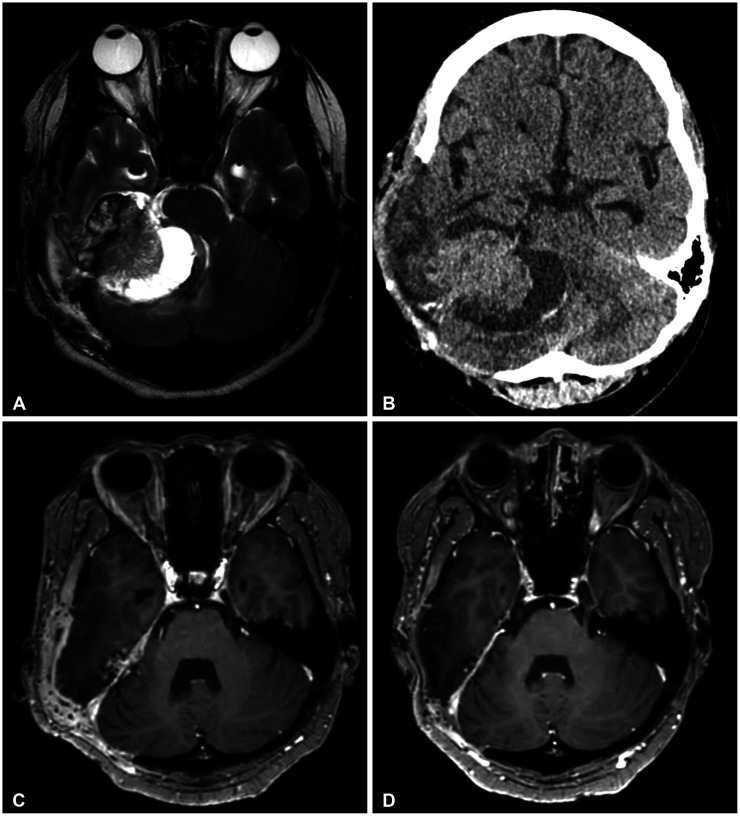Brain Tumor Res Treat.
2023 Oct;11(4):281-288. 10.14791/btrt.2023.0030.
Primary Intracranial Ewing Sarcoma With EWSR1-FLI1 Gene Translocation Mimicking a Meningioma and a Multidisciplinary Therapeutic Approach: A Case Report and Systematic Review of Literatures
- Affiliations
-
- 1Department of Premedicine, Seoul National University College of Medicine, Seoul, Korea
- 2Departments of Neurosurgery, Seoul National University Bundang Hospital, Seoul National University College of Medicine, Seongnam, Korea
- 3Departments of Internal Medicine, Seoul National University Bundang Hospital, Seoul National University College of Medicine, Seongnam, Korea
- 4Departments of Radiology, Seoul National University Bundang Hospital, Seoul National University College of Medicine, Seongnam, Korea
- 5Departments of Pathology, Seoul National University Bundang Hospital, Seoul National University College of Medicine, Seongnam, Korea
- KMID: 2547418
- DOI: http://doi.org/10.14791/btrt.2023.0030
Abstract
- Ewing sarcoma and peripheral primitive neuroectodermal tumor (ES/pPNET) is an undifferentiated malignant tumor that is most prevalent in children and young adults and often radiologically mimics a meningioma. A 38-year-old female patient visited our hospital with complaints of right-sided tinnitus, right hemiparesis, and imbalance. She underwent preoperative imaging and was subsequently diagnosed as having a meningioma on the petrous ridge. After partial resection, EWSR1-FLI1 gene fusion was confirmed, and she was diagnosed with ES/pPNET. The tumor was successfully treated using a multidisciplinary approach of adjuvant chemo- and radiotherapy. This case is noteworthy because it is an extremely rare case of an intracranial ES/pPNET, and it is worth sharing our clinical experience that the tumor was successfully treated through a multidisciplinary therapeutic approach even though complete resection was not achieved.
Figure
Reference
-
1. Chen J, Cheng R, Fan F, Zheng Y, Li Y, Chen Y, et al. Cranial Ewing sarcoma/peripheral primitive neuroectodermal tumors: a retrospective study focused on prognostic factors and long-term outcomes. Front Oncol. 2019; 9:1023. PMID: 31649882.
Article2. Deshpande G, Epari S, Gupta C, Shetty O, Gurav M, Chinnaswamy G, et al. Primary intracranial Ewing sarcoma/peripheral primitive neuroectodermal tumor, an entity of unacquaintance: a series of 8 cases. Childs Nerv Syst. 2021; 37:839–849. PMID: 32761378.
Article3. Geng Z, Gao W, Cheng W, Wu A. Primary intracranial Ewing sarcoma invading the superior sagittal sinus with EWSR1-FLI1 gene fusion and EWSR1 gene mutation: a case report and literature review. World Neurosurg. 2023; 175:1–10. PMID: 36990350.
Article4. Jiang Y, Zhao L, Wang Y, Liu X, Wu X, Li Y. Primary intracranial Ewing sarcoma/peripheral primitive neuroectodermal tumor mimicking meningioma: a case report and literature review. Front Oncol. 2020; 10:528073. PMID: 33123461.
Article5. Cherif El Asri A, Benzagmout M, Chakour K, Chaoui MF, Laaguili J, Chahdi H, et al. Primary intracranial pPNET/Ewing sarcoma: diagnosis, management, and prognostic factors dilemma–a systematic review of the literature. World Neurosurg. 2018; 115:346–356. PMID: 29729469.
Article6. Yim J, Lee WS, Kim SK, Kang HJ, Bae J, Park SH. Intracranial Ewing sarcoma with whole genome study. Childs Nerv Syst. 2019; 35:547–552. PMID: 30406421.
Article7. Haveman LM, Ranft A, Berg HVD, Klco-Brosius S, Ladenstein R, Paulussen M, et al. Primary and metastatic intracranial Ewing sarcoma at diagnosis: retrospective international study and systematic review. Cancers (Basel). 2020; 12:1675. PMID: 32599807.
Article8. Mazur MA, Gururangan S, Bridge JA, Cummings TJ, Mukundan S, Fuchs H, et al. Intracranial Ewing sarcoma. Pediatr Blood Cancer. 2005; 45:850–856. PMID: 15929128.
Article9. Tanboon J, Sitthinamsuwan B, Paruang T, Marrano P, Thorner PS. Primary intracranial Ewing sarcoma with an unusually aggressive course: a case report and review of the literature. Neuropathology. 2012; 32:293–300. PMID: 22007764.
Article10. Ke Ch, Duan Q, Yang H, Zhu F, Yan M, Xu SP, et al. Meningeal Ewing sarcoma/peripheral PNET: clinicopathological, immunohistochemical and FISH study of four cases. Neuropathology. 2017; 37:35–44. PMID: 27500883.
Article11. Kumar V, Singh A, Sharma V, Kumar M. Primary intracranial dural-based Ewing sarcoma/peripheral primitive neuroectodermal tumor mimicking a meningioma: a rare tumor with review of literature. Asian J Neurosurg. 2017; 12:351–357. PMID: 28761507.
Article12. VandenHeuvel KA, Al-Rohil RN, Stevenson ME, Qian J, Gross NL, McNall-Knapp R, et al. Primary intracranial Ewing’s sarcoma with unusual features. Int J Clin Exp Pathol. 2015; 8:260–274. PMID: 25755713.13. Salunke P, Sharma M, Gupta K. Ewing sarcoma of the occipital bone in an elderly patient. World Neurosurg. 2014; 81:e10–e12.
Article14. Cole M, Parajuli S, Laske D, Goldstein L, Morrison T, Mukherjee A, et al. Peripheral primitive neuroectodermal tumor of the dura in a 51-year-old woman following intensive treatment for breast cancer. Am J Case Rep. 2014; 15:294–299. PMID: 25045413.
Article15. Antonelli M, Caltabiano R, Chiappetta C, Oliva MA, Giangaspero F, Lanzafame S. Primary peripheral PNET/Ewing’s sarcoma arising in the meninges, confirmed by the presence of the rare translocation t(21;22) (q22;q12). Neuropathology. 2011; 31:549–555. PMID: 21284749.
Article16. Mellai M, Caldera V, Comino A, Fortunato M, Bernucci C, Schiffer D. PNET/ESFT of the cranial vault: a case report. Clin Neuropathol. 2010; 29:372–377. PMID: 21073841.
Article17. Attabib NA, West M, Rhodes RH. Peripheral primitive neuroectodermal tumor of the cavernous sinus: case report. Neurosurgery. 2006; 58:E992. PMID: 16639307.
Article18. Mobley BC, Roulston D, Shah GV, Bijwaard KE, McKeever PE. Peripheral primitive neuroectodermal tumor/Ewing’s sarcoma of the craniospinal vault: case reports and review. Hum Pathol. 2006; 37:845–853. PMID: 16784984.
Article19. D’Antonio A, Caleo A, Garcia JF, Marsilia GM, De Dominicis G, Boscaino A. Primary peripheral PNET/Ewing’s sarcoma of the dura with FISH analysis. Histopathology. 2004; 45:651–654. PMID: 15569062.
Article20. Simmons MA, Luff DA, Banerjee SS, Ramsden RT. Peripheral primitive neuroectodermal tumour (pPNET) of the cerebellopontine angle presenting in adult life. J Laryngol Otol. 2001; 115:848–852. PMID: 11668007.
Article21. Kalamarides M, Dewolf E, Couvelard A, Shahidi A, Bouccara D, Cyna-Gorse F, et al. Extraaxial primitive neuroectodermal tumor mimicking a vestibular schwannoma: diagnostic and therapeutic difficulties. Report of two cases. J Neurosurg. 2001; 94:612–616. PMID: 11302660.
Article22. Papotti M, Abbona G, Pagani A, Monga G, Bussolati G. Primitive neuroectodermal tumor of the meninges: an histological, immunohistochemical, ultrastructural, and cytogenetic study. Endocr Pathol. 1998; 9:275–280. PMID: 12114719.
Article




